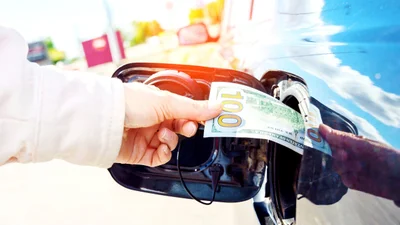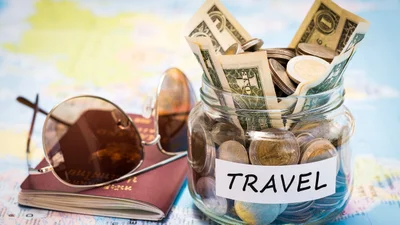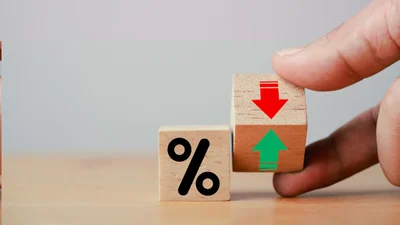Best CD rates of November 2023 (Up to 5.60%)
Updated 5:39 p.m. UTC Nov. 27, 2023
Editorial Note: Blueprint may earn a commission from affiliate partner links featured here on our site. This commission does not influence our editors' opinions or evaluations. Please view our full advertiser disclosure policy.
For much of the past 15 years, thanks to low interest rates and almost nonexistent inflation, few were interested in certificates of deposit (CDs). That indifference is gone after the Federal Reserve hiked borrowing costs in a determined effort to stabilize decades-high price gains caused by federal and state governments spending unprecedented amounts following economic shutdowns that were imposed to thwart the novel coronavirus.
All of which means, CDs are now worthy of a place in your financial plan.
Annual percentage yields (APYs) and account details are accurate as of November 20, 2023.
Why trust our banking experts
Our team of experts evaluates hundreds of banking products and analyzes thousands of data points to help you find the best product for your situation. We use a data-driven methodology to determine each rating. Advertisers do not influence our editorial content. You can read more about our methodology below.
- 140 CDs from 84+ financial institutions reviewed.
- 4 levels of fact checking.
- 50+ data points analyzed.
Best CD rates
Compare the best CDs
For easy comparison, here are all the best CDs all in one place.
Methodology
CDs used to play an important, albeit complimentary, role in the finances of everyday Americans. Roughly a fifth of households owned a CD in 1989, according to the Fed. They were still in vogue nearly two decades later, as more than 16% used them in 2007.
In 2019, however, only 7.7% of households had a CD.
The reason? CDs used to be a much better deal. At the beginning of 1989, for instance, a one-year CD offered an 8.30% APY. By 2007, it was just 3.7%.
By 2019, a one-year CD paid just 0.92%.
The story behind drooping CD rates is complicated, and it involves: falling inflation (until recently), an aging population, technological innovations and the Federal Reserve lowering interest rates. The aftermath of the Great Recession, in which the Fed kept interest rates near zero for almost a decade as inflation continually ran under its desired level, is just the most recent trend.
That’s what has made the current moment so interesting. CD yields jumped in 2022 after the Fed raised rates by 4.25 percentage points in nine months.
The upshot, though, is the same: Americans are more likely to consider CDs if they pay more in interest, especially compared to inflation. After all, a one-year CD that pays less than 1% is hardly worth it when prices are rising at twice as high a rate.
We took this historical lesson to heart when crafting our ratings, as you can see below:
- APY: 70%.
- Customer Experience: 10%.
- Minimum Deposit: 5%.
- Compound Interest Schedule: 5%.
- Digital Experience: 5%.
- Available Terms: 3%.
- Availability: 2%.
We looked at the terms of 144 CDs offered by 84 banks and credit unions to reach our rankings. In each category we looked at a variety of factors.
For instance, to determine APY, we documented the interest rate offered on 17 different terms. To rank customer service, we documented how the financial institutions were ranked by the Better Business Bureau and JD Power.
Additionally, we valued accounts with lower minimum deposits, daily compound interest schedules (rather than monthly) and those that are available to everyone, regardless of where they live.
While non-APY factors are important, we believe that your potential earnings should reign supreme.
Why some banks didn’t make the cut
Stare at our rankings for a while and something obvious becomes apparent: a dearth of big banks.
No Chase Bank, no Bank of America, no Citi® and no Wells Fargo. The four largest financial institutions in the nation, which together own nearly $10 trillion in assets, don’t offer a competitive CD.
How come?
Well, they don’t have to.
The big banks enjoy the benefits of generations of customers and high name identification. When the typical person thinks about opening a bank account, their mind tends to drift towards at least one of the big four.
If a bank wants to make a splash, then, they need to offer higher rates.
The story is similar for the next three biggest banks: U.S. Bank, PNC Bank and Truist, regional powers all. Their offerings are either not high enough, or aren’t robust enough, to warrant inclusion.
The only top 10 banks to make the cut prove the point. Capital One and Goldman’s Marcus by Goldman Sachs each offer high rates in an effort to win business from more established banking institutions. After all, Capital One is basically a Gen Zer (it was conceived in the mid-1990
Best 1-year CD rates
One-year CDs currently occupy the sweet spot for CD shoppers, thanks to a minimal commitment and high yields. (That’s largely thanks to the Federal Reserve raising short-term rates significantly, while market observers believing the economy will slow in the years-to-come).
As of November 17, 2023, the current national high rate for a 12-month CD is 5.70% APY according to Curinos data (rates are based on a $25,000 minimum deposit).
Learn more: Best 1-year CD rates.
Best 6-month CD rates
If you have a short time-period in which to save, consider these six-month CD options. You can earn a high yield, and get back into the market quickly should yields stay high.
As of November 17, 2023, the current national high rate for a 6-month CD is 5.59% APY according to Curinos data (rates are based on a $25,000 minimum deposit).
Learn more: Best 6-month CD rates.
Best 5-year CD rates
You can typically earn the most interest on longer CD terms. If you don’t need to touch some cash for a while, 5-year CDs can be a great option. See the link below for more information on each CD and on how we determined the best.
As of November 17, 2023, the current national high rate for a 5-year CD is 5.20% APY according to Curinos data (rates are based on a $25,000 minimum deposit).
Learn more: Best 5-year CD rates.
How to choose the best CD
Prioritize rates. The main purpose of investing is to earn money. Research the highest CD rates available, which are typically offered by online banks and smaller financial institutions.
Consider time. How long are you willing to lock away your funds? Can you afford to hand over a bundle of your cash for six months? One year? 10 years? Make sure you have a fully-financed emergency fund before you consider a CD.
Look at withdrawal allowances. If you need to, are you able to make an early withdrawal? If so, what would the penalty be? Ideally you’d want to opt for a CD that charges little in the way of fees. If you are at all concerned about needing the money in the near future, consider opting for a no-penalty CD. While interest rates are typically lower, you won’t be penalized if you need to access your cash.
Check requirements and insurance. Many CDs require a minimum balance, such as $1,000. Make sure you can meet the requirements to open the CD you desire. And be careful that any CD you open will be completely covered by deposit insurance from the Federal Deposit Insurance Corporation (FDIC) or the National Credit Union Administration (NCUA), which guarantee funds up to $250,000 for each depositor at each covered institution.
See CD types. If traditional CDs aren’t meeting your needs, look up other types. For example, no-penalty CDs allow you to make fee-free withdrawals; add-on CDs typically have low minimum requirements and allow you to increase your principal over time; bump-up CDs allow you to request an APY increase, which can be useful in a rising-rate environment.
Compare CDs. After you do all of the steps above and have a list of top CDs, look at your options and make a choice. You could also use a CD calculator.
Comparing CD rates
It’s easy to compare the face value of one CD rate to another: A higher number is better. Yet when CDs are for different terms, it can be much harder to know how one will pay off versus another.
To better judge apples to apples, use a CD calculator. It’ll determine the dollar amount you’ll earn from each CD, which may make your decision easier.
Rates are currently highest for CDs with terms between one and three years, though there are exceptions. Focus on those terms, especially if you’re considering employing a CD ladder.
National average interest rate for CDs
Here are the national deposit rates as of November 20, 2023, according to the Federal Deposit Insurance Corporation (FDIC).
Are CD rates going up?
Long-suffering savers got something of a break in 2022: higher CD yields.
After more than a decade of low interest rates following the Great Recession, the Federal Reserve has raised rates by more than four percentage points so far in an effort to snuff out decades-high inflation.
This resulted in the interest rates on one-year CDs, for instance, to jump by almost one percentage point to 1.07% by the end of 2022.
While prices are returning to more normal inflation levels in recent months, it appears that Federal Reserve Chair Jerome Powell will still push the central bank to increase rates, albeit at something of a slower pace.
“Powell continues to stress that the Fed is committed to getting inflation down and the market expects roughly another 60 bps of hikes in the first part of the year, followed by cuts towards the end of the year,” said Nancy Davis, founder of Quadratic Capital Management.
CD rates rise and fall with the federal funds rate, which is set by the Federal Reserve. The Fed makes rate changes in an effort to grow or suppress the economy, depending on what’s going on with inflation. Increasing the federal funds rate makes borrowing more expensive, and thereby limiting economic activity.
Because money is more expensive, you can get a higher interest rate on your deposits. The money you’re effectively lending to financial institutions commands a better APY. Exactly when CD rates will plateau and how high the rates will reach before they drop, is unknown, but here’s our CD rates forecast.
But expect CD rates to continue to look good, especially compared to where they were just a few years ago.
How to build a CD ladder
A CD ladder allows you to earn higher rates offered by longer terms without locking up your cash forever.
For example, assume you have $9,000 to invest and you make a ladder of three CDs. You put $3,000 each into one, two and three-year CDs. When the one-year CD matures, you convert it to the higher-rate, 36-month CD, then do the same with the 24-month CD. This way you end up with three 36-month CDs with high APYs, with one maturing each year.
Here are the steps to build a CD ladder of your own:
- Divide the amount of money you want to invest by however many CD terms you want.
- Research the best CDs to find the best providers and the best rates for different lengths.
- Open and set up the CD accounts you want.
- As the CDs mature, reinvest the cash into longer term CDs.
The second step, however, is crucial. Just because the Fed has raised interest rates doesn’t mean that you’ll get the same, or even similar rates, from different financial institutions on the same CD term.
“Even though rates are rising, not all banks will raise your savings interest rate accordingly,” said Tony Molina, a CPA at Wealthfront. “Make sure you move your money to an account that passes on the increased rates to you-otherwise you’re missing out on basically free money.”
A CD ladder gives you the freedom to cash out a hunk of money if you need it or reinvest your money without sweating about locking away your funds—because your next CD is maturing next year.
How are CDs taxed?
In most cases, Uncle Sam counts the money you make from your deposits as taxable income. If you earn $10 or more, a financial institution should send you (and the IRS) an annual 1099-INT form that reports your interest earnings. If you don’t receive a form, you’re still responsible for reporting the income.
If you make at least $1,500, you’ll also need to itemize your sources of interest income on Schedule B of the 1040. The good news is that there are some exceptions, but they mostly apply to investment vehicles issued by the government.
The amount you pay depends on your specific marginal tax bracket.
Income interest from treasury bills, notes and bonds, such as I Bonds, are exempt from state and local income taxes.
What happens to CDs at maturity?
When a CD matures, you have a grace period (typically seven days) in which you can either renew the CD term, or withdraw the funds entirely. Many CDs automatically renew if you do not withdraw them.
Renewing generally provides two options. You could reninvest the original amount plus the interest you’ve earned or reinvest only the original amount.
Withdrawing the funds can pay off if you use them to invest in other CDs with higher yields. In the time between your purchasing of the CD and its maturity, APYs have likely changed. Your financial needs and abilities may have altered as well. Withdrawing your mature CD to reinvest in a new deposit vehicle that better suits can be smart.
CD rates change on a regular basis. But, of course, a higher CD rate is always better. As of November 20, 2023, the national average rate on a 12-month CD is 1.85% APY. However, you can find many banks offering APYs well above this national average, especially if you consider the winners in our ranking.
You’ll typically need the following pieces of information in order to open a CD: your name, address, Social Security Number, government issued identification and phone number. You can provide this information either online, or in person, though you’ll likely find the best rates on the former. Once you’re approved, you’ll be able to fund the CD either with money from a connected bank account or one not affiliated with the bank altogether.
Savings accounts allow you to make deposits whenever you want, as well as make withdrawals without penalty. They have no term limit, though you’re not guaranteed a particular interest rate. By contrast, traditional CDs require that you lock away a set amount of money for a set amount of time. If you can make a withdrawal at all, you almost always have to pay a financial penalty for doing so. The trade off is that CDs generally have higher yields; however, high-yield savings accounts can be competitive.
While it’s easy to get excited about high yields on long-term CDs, it’s still vital to confirm that a long-term investment fits within your overall financial strategy. That is, buy a high-yielding CD if it makes sense within your larger financial plan.
CD rates are expected to go up in 2023, following the trend of rising rates as the Federal Reserve continues to fight inflation.
Editor’s Note: This article contains updated information from previously published stories:
Blueprint is an independent publisher and comparison service, not an investment advisor. The information provided is for educational purposes only and we encourage you to seek personalized advice from qualified professionals regarding specific financial decisions. Past performance is not indicative of future results.
Blueprint has an advertiser disclosure policy. The opinions, analyses, reviews or recommendations expressed in this article are those of the Blueprint editorial staff alone. Blueprint adheres to strict editorial integrity standards. The information is accurate as of the publish date, but always check the provider’s website for the most current information.




























